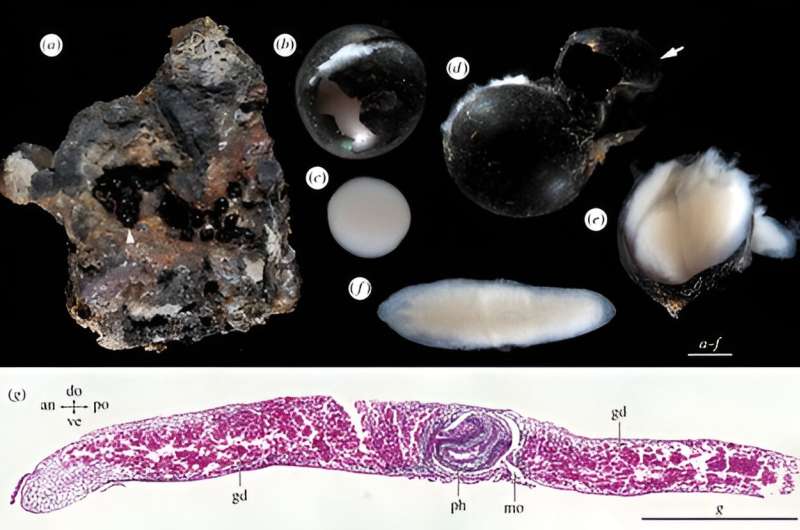January 24, 2024 report
This article has been reviewed according to Science X's editorial process and policies. Editors have highlighted the following attributes while ensuring the content's credibility:
fact-checked
peer-reviewed publication
trusted source
proofread
Dark black eggs found on ocean floor represent deepest free-living flatworms ever observed

A pair of marine scientists at Hokkaido University, in Japan, has found evidence of the deepest free-living flatworms ever observed. In their study, published in the journal Biology Letters, Keiichi Kakui and Aoi Tsuyuki, identified flatworm eggs found on the seafloor at a depth of more than 6,000 meters.
Marine flatworms exist in all the world's oceans, though they are most common in the tropics or near undersea volcanos. They typically live beneath rocks on the seabed and move using hair-like bristles—many species have been found to create waves as they swim, pushing predators away. Little else is known about abyssal free-living platyhelminth. In this new effort, Kakui and Tsuyuki found a species that exists at far greater depths than most others of their kind.
The dark black clutch of eggs was discovered by another researcher, Yasunori Kano of the University of Tokyo, as he was piloting a remote undersea vehicle in the Kuril-Kamchatka Trench, in a northwestern part of the Pacific. After discovering the eggs, he collected samples and brought them to the research pair for investigation. He stated that they had been found at a depth of 6,200 meters.
After initial testing, the researchers discovered that the eggs represented something rare—they sent a trawling ship to capture more specimens, which they subjected to more thorough testing.
The researchers found that the eggs were actually flatworm egg capsules, each approximately 3 mm in diameter, that contained three to seven flatworms. Genetic analysis showed that they belong in suborder Maricola in Tricladida, similar to their shallow-water cousins, a finding that established them as the deepest free-living flatworms ever observed.
Their similarity to other species, the researchers note, suggests that they developed adaptations that allowed them to survive in deeper water. Study of such adaptations could offer insights into how creatures in general adapt to such extreme environments.
The researchers plan to continue the study of the capsules and the flatworms inside them, hoping to learn more about their life cycle and perhaps marine flatworm evolution.
More information: Keiichi Kakui et al, Flatworm cocoons in the abyss: same plan under pressure, Biology Letters (2024). DOI: 10.1098/rsbl.2023.0506
Journal information: Biology Letters
© 2024 Science X Network




















